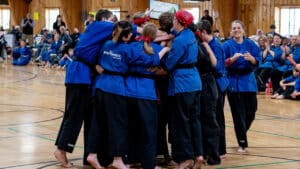People often ask about how doing martial arts is different than any doing other sport for kids. The following answer might surprise you.
The first thing that comes to mind when people think of martial arts is “fighting.” While other sports offer defensive and offensive maneuvers, it’s not the same as throwing and dodging punches and kicks.
But the difference between a system of martial arts training and other forms of sports or exercise that parents seek out for kids has to do with something I’ll call the “360 Approach.”
Team sports like soccer and basketball, individual sports like track and tennis, and even classical combat sports like wrestling are all active, fitness-oriented, and contact-based (i.e., you get hit or at least pushed around). They’re all competitive. All involve written rules and sportsmanship. All demand that kids listen to coaches and respect their teammates and competitors, challenging each other to become stronger, faster, better.
So why choose martial arts? The answer comes in two words, one concept: Black Belt. The goal toward earning a black belt in any martial art, whether it’s jiu jitsu, karate, taekwondo, or some (as at Ripple Effect Martial Arts) combination of styles, is paramount. It’s a bit like the old saying of “Give a person a fish, and she eats for a day. Teach her to fish, and she eats for a lifetime.”
What you’re learning on the journey to black belt is not just applicable in a self-defense scenario or even limited to the field of martial arts itself. These are life skills that you’re as likely to use in the schoolyard or office or airport as in a dark alley. Current students have already glimpsed this; right from the beginning, white belts explore concepts like courage, integrity and respect through worksheets and mat chats.
Job lists that track the completion of chores at home help keep kids accountable for taking out the trash and brushing their teeth. Intent to Promote forms create a bridge between the karate and elementary schools for kids, involving parents and teachers in the process of belt promotion.
This is the “360 Approach” at work. As kids advance in their martial arts training, it goes deeper, with leadership projects and volunteer engagements that every single black-belt-bound student takes on. The program that began (and continues, and concludes) with kicking and punching comes to incorporate a positive impact in the community.
To come back to the original sentence: All sports are important. When taught well, all sports will improve kids’ focus, attention, respect, endurance and strength. But black belt training in karate or a range of martial arts goes beyond, incorporating at its core a responsibility to family, teachers, and the community at large.
As a result (and this is the best part), your black belt becomes an umbrella under which you can explore virtually any other pursuit you have in life; the skills learned on the black belt battlefield translate to how kids relate to classmates, to brothers and sisters, to their parents and teachers, and to their own career trajectory.
Really internalize this as you begin your black belt journey, and help your kids internalize and exercise it too. With this mindset, you’ll see it at work at home, school and karate, right from the start.



